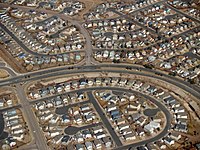
Photo from wikipedia
Abstract Introduction Growth of population, economic activities, and travel demand has resulted in serious problems, including air pollution, particularly in the large cities of developing countries. Many metropolitan areas are… Click to show full abstract
Abstract Introduction Growth of population, economic activities, and travel demand has resulted in serious problems, including air pollution, particularly in the large cities of developing countries. Many metropolitan areas are thus now seeking strategies to encourage the use of sustainable travel modes, which is significantly affected by built environment (BE). This study examines the impact of BE on walking choice and distance for discretionary trips, namely recreational and shopping trips for the case of Tehran, Iran. Circular buffer is used to explore characteristics of close neighborhoods, while transport-analysis-zone (TAZ) for wider neighborhoods Method This study uses a Heckman selection model based on trip characteristics, socioeconomic variables, and objective BE. This two-stage model combines a regression model of walking distance and a binary probit model of walking choice, using Origin-Destination travel data of a clustered sample of 743 Tehran residents in 2014. Results Residential density, commercial density, and mixed land-use are observed to have a positive effect on walking distance. Highway density, average block size, and distance to the closest gym have a negative effect on the probability of walking, while the number of bus stations has a positive effect. Also, TAZs with lower–than-mean parking capacity (at destinations) are observed to have a strong tendency toward walking. Conclusion As the first walking distance model (to our knowledge) to include a parking supply measure, this study can provide insight into walking behavior. Developing neighborhoods with lower highway density, smaller blocks, more gyms, higher mixed land-use, and higher residential and commercial density can encourage people to walk as long-term policies, while parking management like reducing parking capacity as short-term policies.
Journal Title: Journal of transport and health
Year Published: 2021
Link to full text (if available)
Share on Social Media: Sign Up to like & get
recommendations!